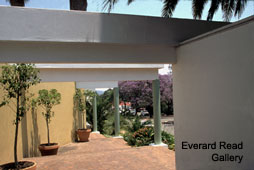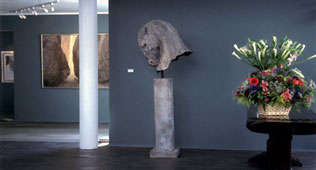-
EVERARD READ GALLERY
Johannesburg, South Africa, 2000"DIVERSITIES"
 It’s
April and I’m sitting, slightly bemused by jet lag, in the
cool late spring air atop a gently vibrating ferry that will deposit
me at Fulford Harbour — the village that serves as port, convenience
store and post office for the fortunate inhabitants of Saltspring
Island, British Columbia. For the next much anticipated few days,
Christine and I will be the house guest of a man whose images of
pristine wilderness has affected the imagination of countless people
worldwide.
It’s
April and I’m sitting, slightly bemused by jet lag, in the
cool late spring air atop a gently vibrating ferry that will deposit
me at Fulford Harbour — the village that serves as port, convenience
store and post office for the fortunate inhabitants of Saltspring
Island, British Columbia. For the next much anticipated few days,
Christine and I will be the house guest of a man whose images of
pristine wilderness has affected the imagination of countless people
worldwide. As a young man I well remember devouring the first books that featured the paintings of Robert Bateman. A buffalo, chin-up, sniffing a rift valley morning breeze made me determined to abandon my chosen career path and head off to Tanzania. The next page would illustrate in gentle mauve light a low floating iceberg with the breath mist of a passing pod of whales. Suddenly the high latitudes were the only place for me. An impossibly ravishing tiger painted in its water-saturated environs would confuse me further.
The view from the top deck of our ferry is enchanting. Clean, black and to a South African, frigid looking water supports the odd floating kelp frond and common loon. It stretches to rocky beaches which define the edges of numerous Douglas Fir clad islands that appear and slide past, each one more charming and pristine in turn as the ferry moves away from the relative bustle of Vancouver Island. This view, highlighted by the brilliant silvery white of a passing glaucous winged gull was to me, unnervingly close to nothing other than a fresh retinal image taken from the eye of the artist who will meet me at the quayside in a few minutes time.
Looking back in time, it’s not possible to dream about those now thankfully ancient pestilence ridden late Gothic times without one’s imagination being grabbed by the cold analytical stare of Albrecht Dürer or Lucas Cranach. Similarly, Nineteenth Century England was pictorially subjugated by Constable. Dark oak trees, a friendly brook with a young fisherman, scudding clouds with a distant church spire – this stuff was John Constable.
To drive through England today is to drive into a landscape where one has to constantly acknowledge “Oh, that looks just like a John Constable”. Constable claimed the rural landscape of England as his own and the vigour of his vision has dominated the work of generations of rural landscape artists ever since. Robert Bateman has done precisely the same with his haunting images of our planet’s wilderness and the organisms that inhabit it.
When one has spent a bit of time assimilating Bateman’s imagery (and it takes a bit of time as his work is full of information) it is difficult to immerse oneself in unspoilt wilderness without looking at it through his eyes. That, in essence, is the strength of his art. It is also the reason why he is easily the most influential natural history painter of his generation. His work is most often quiet and introspective yet the muted tones and brilliant draughtmanship combine remarkably often into a work of art that is a seeringly intelligent comment on the sheer unadulterated beauty that is planet earth.
 An
orca slipping into calm waters below kelp, a few chimps described
without a trace of anthropomorphism sit in their tropical Eden,
an appraising timberwolf standing in an environment that is absolutely
quiet. In this arena Bateman is unapproachable and it is his rare
gift that he paints pictures where we see the world through the
eyes of the creatures that inhabit that wilderness – a brief
glimpse through their eyes as they go about their business of survival.
An
orca slipping into calm waters below kelp, a few chimps described
without a trace of anthropomorphism sit in their tropical Eden,
an appraising timberwolf standing in an environment that is absolutely
quiet. In this arena Bateman is unapproachable and it is his rare
gift that he paints pictures where we see the world through the
eyes of the creatures that inhabit that wilderness – a brief
glimpse through their eyes as they go about their business of survival.
Mark Read
October 2000
